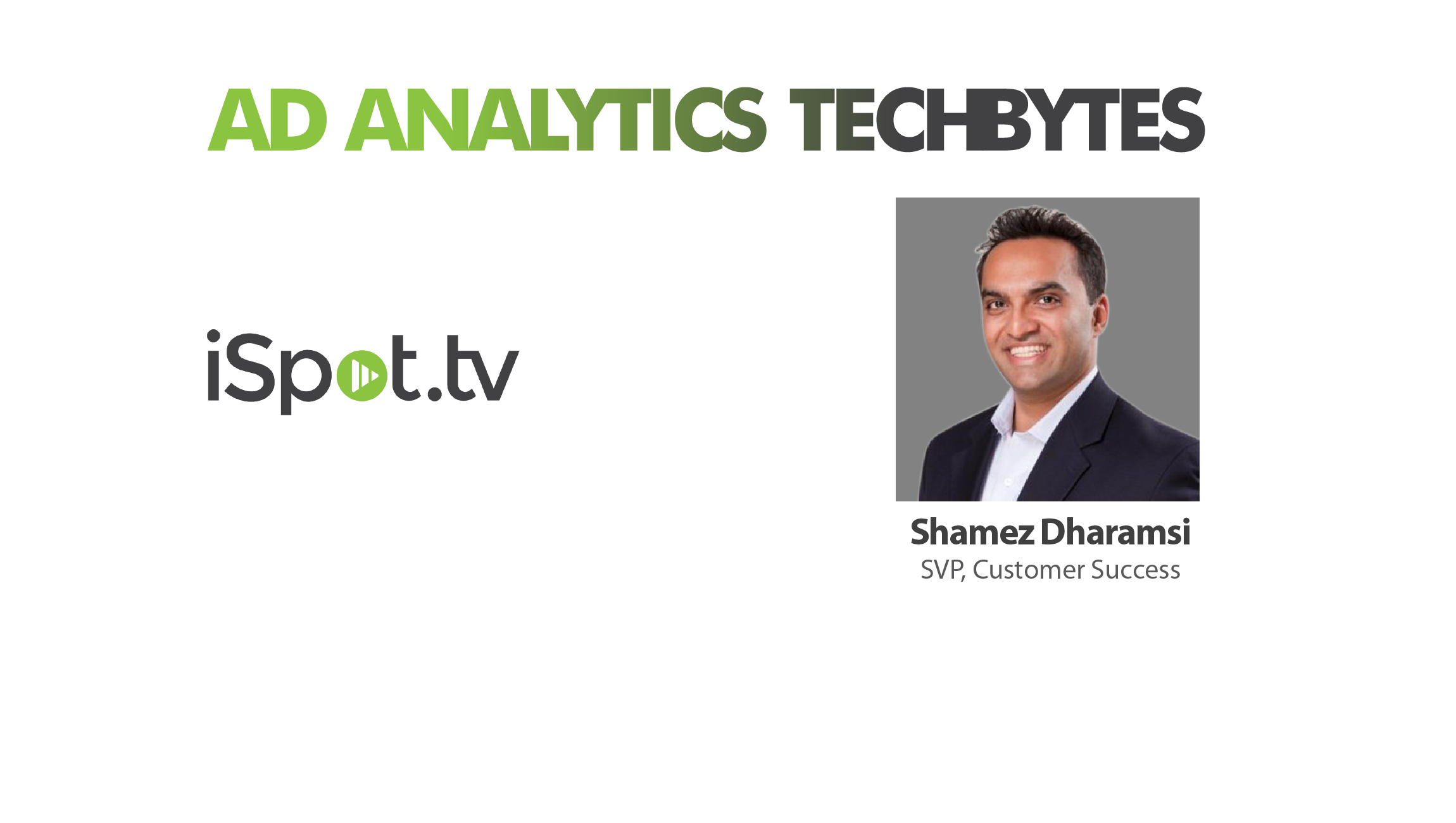Shamez Dharamsi
SVP, Customer Success, iSpot.tv
How do you find out if consumers are paying enough attention to your advertisements? iSpot.tv, a leading real-time TV ad analytics company offers Attention Score, a measure of how consumers react to TV ads. We spoke to Shamez Dharamsi, SVP, iSpot, to understand how TV ad analytics would change in the years to come.
Html code here! Replace this with any non empty text and that's it.
MTS: Tell us about your role and what inspired you to be a part of a technology innovation company?
Shamez Dharamsi: I started my career as a marketer, when data-driven marketing was in its infancy. My initial love for marketing grew out of my study of consumer behavior — how consumers interact with brands, how they consider brands, as well as their purchase behavior. Over the course of my career, I have transitioned from being a marketer to advising Fortune 1000 companies as a marketing strategy partner (working within the advertising agency framework, and most recently at technology-enabled SaaS companies).
My current role involves building and managing the Customer Success function at iSpot.tv. This involves partnering with our customers to understand their needs (which feed into the iSpot product), uncovering and delivering the insights that help our customers take action, that ensures that customers continue to realize the value of their investment with iSpot. One of the key values at iSpot is for us to be customer-first, both in our service approach as well as the evolution of our product.
My roots in Marketing, and Martech/Adtech (SaaS, Insights, and Analytics) continue to provide the foundation for the advisory work that I do with our customers today to help them make data-driven decisions on their TV advertising investment (while understanding their technology and analytics aspirations and constraints).
MTS: Given the changing dynamics of ad engagement with customers, how do you see the AdTech market evolving in the years to come?
Shamez: I think three key areas are going to continue to evolve within AdTech, namely, programmatic, personalization and transparency.
Programmatic leverages data-driven segmentation to position the right creative in front of a target customer. As machine learning and AI become more commonplace, programmatic will continue to grow. Moreover, marketers will need to become more comfortable with the technology to earmark a portion of their budgets to be driven through programmatic.
At its inception, the key tactical goal of personalization (beyond the right message to the right customer at the right time) for marketers was to drive email click-throughs to content (through marketing automation). This tactical goal also applies to content marketing and social engagement. However, engagement through content scratches the surface – as marketers are being held more accountable for driving demand generation, CMOs are being asked about their contribution to the company’s top and bottom line. Leveraging personalization to link a brand’s story (and related content) to a consumer’s action can be a great way to connect the dots.
Transparency is the bedrock for a healthy brand-customer relationship. Organizations continue to become data-driven in an effort to triangulate how to best serve content to customers. However, they must simultaneously provide transparency to customers regarding what data they are collecting, what data they may be sharing or selling to other organizations, and how customer data will be used. In addition, providing customers with the ability to dictate the content served to them can result in deeper customer relationships.
MTS: What do you see audience attention and conversion analytics influencing their omnichannel experience?
Shamez: Many advertisers primarily consider TV as a reach medium, leveraging TV as a vehicle to drive brand recognition and awareness. Now that televisions and specifically, TV ads can be connected to attribution, marketers are able to connect the dots between ‘viewing and doing’ – in other words, is my ad being watched and is the viewer taking an action, such as visiting my website or downloading my app?
I believe that TV is the last frontier in terms of a content delivery channel that needs to be conquered by marketers (in terms of measurement). Others channels such as digital and social, are much further along in being able to connect the dots of the customer journey. A brand is introduced at the top of the funnel, engagement occurs mid-funnel, then a pinpointed sales action takes place lower in the funnel.
Historically, we have been able to decipher what aired and what was spent from TV. Show ratings told us the potential for ad viability and performance, but only in the context of the program where the ad appeared. With the advent of new technology, we are now able to look at TV ads in real-time and the attention and conversions that they drive. Marketers are no longer held hostage to delayed and in many cases incomplete insights around their TV ad investment.
They can now answer questions such as: Who’s watching my (my competitor’s) ad, who’s interrupting ad play, and what call-to-action is being driven by my ad?
MTS: What’s the biggest challenge that CMOs need to tackle to make their media decisions work?
Shamez: The biggest challenge CMOs need to tackle in order to make media decisions revolves around the speed with which customers engage with content. In order to address this, CMOs must have access to granular and just-in-time insights. For example, if a CMO has real-time visibility into which creative on which day part is underperforming (e.g. are viewers tuning away? Is my creative driving brand consideration KPIs on my website?), they can optimize media decisions very quickly and effortlessly.
Historically, CMOs have been able to understand what happened to an ad, in very generic terms. With some work, they could decipher which creatives work for which target audience, and make estimations around how consumers may have responded to a call-to-action. Digital and social solutions take this a step further with statistical attribution models used to determine what is driving interest for a brand or product.
As CMOs continue to be under pressure to drive top and bottom line growth within the organization, they are being asked to prove the value of their TV advertising investment. In order to do that, they need to be able to connect their ad investment to ad engagement (attention scores and creative wear) to a call-to- action (brand and product evaluation and in many cases, sales). Where technology historically didn’t provide information past the top-of-funnel information, it does now.
MTS: What statups, from the analytics industry, are you following keenly?
Shamez: We’re working with a start-up that was spun out of Vizio, called InScape, which allows us to get analytics straight from the glass in the television (smart TVs). Matched with iSpot’s robust TV ad catalog, it allows help marketers understand the customer journey (especially along the last mile).
One company in Seattle, Azuqua, simplifies cloud application connectivity by allowing the organization to connect its most used and most popular apps (and adjacent business processes). Think of all of the data (and processes) that exist within an organization – Azuqua allows you to pull it all together and seamlessly include additional business process and rules, as needed.
Another company in Philadelphia, Orai, specializes in AI and machine learning. It started with an app that helped people to become better public speakers, and has most recently pivoted to sales enablement services. Orai allows Fortune 1000 brands to reflect on the ways they’re positioning to customers and prospects using speech analytics.
MTS: How do you leverage customer engagement and sales automation platforms at iSpot?
Today’s marketing stack has to have a few different components:
A customer engagement platform (we use Marketo) and a sales automation platform (we use Salesforce and Highspot) — These tools help us to streamline communications with customers and prospects, better understand the revenue pipeline, and uncover who’s engaging with which content.
In addition, connecting the dots between the data that has been collected and what decisions need to be made requires a robust Insights and Analytics tool. For this important part of the marketing stack, we use a few homegrown analytics tools to dig deeper into the iSpot platform. We also use a couple other off-the-shelf tools such as Tableau and InsightSquared, to help us analyze our performance as a SaaS business.
MTS: Thanks for chatting with us, Shamez.
Stay tuned for more insights on marketing technologies. To participate in our Tech Bytes program, email us at news@martechseries-67ee47.ingress-bonde.easywp.com



